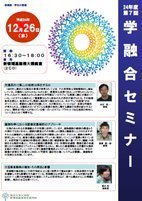AY2012 7th Gakuyugo Seminar
- Date&Time:
- Dec 26, 2012 16:30~18:00
- Venue:
- Large Lecture Room (2C0), New Frontier Science Bldg.

Is There a Second Earth Exist Outside the Solar System?
Professor Eiichi Tajika
Since the first exoplanet was discovered in 1995, the number of discoveries has increased exponentially. The number of planets discovered has increased exponentially since the discovery of the first exoplanet in 1995, and it has become clear that planetary systems are diverse, with many not found in our solar system. In this context, there is a growing interest in "habitable" planets, such as Earth, which are capable of supporting life. One of the most important conditions for a habitable planet is the presence of liquid water. The physical conditions of a habitable planet could include not only a surface ocean like the Earth's, but also an "inner ocean" beneath the ice, seasonal oceans, localized water, and many other possibilities. We will introduce the latest findings on the conditions of habitable planets outside our solar system, and reexamine the characteristics of Earth, the only habitable planet we know of at this time.

Approaches to quantitative image analysis in plant science
Professor Moriichiro Hasezawa
Every physiological function of an organism is dependent on its morphology. The intracellular structure of plant cells is no exception to this rule. Intracellular structures can be divided into membranous and fiber systems according to their morphology, which are functionally and structurally interdependent. Therefore, we believe that it is important to analyze the structure and function of both in a well-balanced manner in cell biology research. In this laboratory, we mainly focus on the cytoskeleton (microtubules and actin fibers) and vacuoles, which are closely related to plant morphogenesis, and have been observing their dynamics during the cell division cycle, differentiation and morphogenesis processes, and environmental responses in real time, as well as conducting quantitative analysis from the obtained image information. From the techniques spun off from the quantitative analysis of images conducted here, we are constructing a system with high plasticity and adaptability to cope with today's diversification and multiplication of images, and aiming to improve the efficiency of image analysis.

Increase in large herbivores, their causes and effects
Associate Professor Maki Suzuki
Foot-and-mouth populations have been increasing worldwide for more than a quarter of a century, and continue to have a major impact on biodiversity and ecosystem functioning. Why are they increasing and what measures are needed? We will take a bird's eye view of this problem from various perspectives, including human social structure and the stability of the ecosystem system, and look for clues to solutions.
*The contents of this page were developed based on a machine translation.

